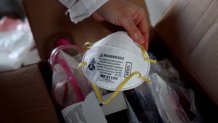With the spiraling coronavirus outbreak numbers in cities and states across the country, U.S. health officials are once again urging people to wear a mask indoors in public, regardless of their vaccination status, in order to help stop its spread.
That's because omicron is much more transmissible than previous coronavirus variants and is driving surges of COVID-19 in much of the country, accounting for more than 73% of new infections, according to the U.S. Centers for Disease Control and Prevention.
Some health experts also say it's time to reconsider your face mask options. Dr. Shira Abeles, infectious disease specialist at UC San Diego Health, says a basic cloth mask isn't going to cut it anymore.
“You have an indoor location, not good circulation, maybe you don't know if people are vaccinated or not and you just have cloth masks and you're in kind of a stuffy room, yeah, it's gonna fail sooner than a very tightly-fitted filtering mask,” Abeles said.
Get top local stories in Southern California delivered to you every morning. >Sign up for NBC LA's News Headlines newsletter.
So, what type of masks are best for the new omicron COVID-19 variant?
Due to the highly transmissible omicron variant, some experts are advising the public to wear well-fitted high-filtration mask like N95 — typically used by health care workers in high-risk environments — amid concerns that the commonly used cloth and surgical masks might not offer enough protection.

Either way, health officials say the best masks are the ones that cover your nose and mouth, and fit snugly so there aren’t any gaps on the sides of your face.
The CDC also says to pick masks with two or more layers and a nose wire to prevent air from leaking out the top. It suggests holding your mask up to check if it blocks light, which means the fabric will probably filter out more particles.
If you want added protection, experts also suggest wearing two masks or pairing them with a mask fitter to ensure they don’t leave any gaps.
What's the different between a N95 and KN95 masks?
An N95 mask is a filtering facepiece respirator (FFR). The Federal Code of Regulations defines an FFR to be a negative pressure particulate respirator with a filter as an integral part of the mask or with the entire face mask composed of the filtering material. An N95 means the mask has been rated to filter at least 95% of airborne particles it encounters. The masks have also been manufactured to form a seal on the wearers face.
The difference between an N95 and a KN95 mask is where the mask is certified. Masks have different approval sources and names based on countries of origin. Those produced in the U.S. and certified by the National Institute for Occupational Safety and Health are called N95, R95 or P95. In China, they are referenced as KN95 and in Europe they are called FFP2.
The CDC warns, however, that 60% of KN95 respirators in the U.S. are counterfeit and not meet NIOSH requirements.



